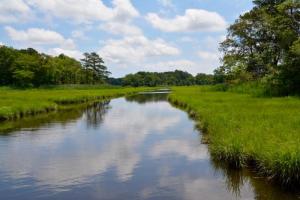Density, buffers on Sussex council docket
.jpg)
Density and buffers – two of the most controversial issues in Sussex County – are front and center before Sussex County Council.
It was Councilman I.G. Burton, R-Lewes, who requested that the items be placed on the June 12 agenda. After an hour-long discussion, council decided to invite experts to further discussions at future meetings. If new ordinances are introduced, public hearings would be scheduled before the planning and zoning commission and county council.
Burton said under current regulations, Sussex County is losing its rural character.
Since the start of Sussex County zoning in 1970, density in residential zoning districts has been computed on the total size of the parcel, not buildable acreage. Everything – wetlands, woods, stormwater ponds – are counted as acreage.
Burton said it's time to take a serious look at that computation. “The calculation of density has never made sense to me,” he said.
The biggest discrepancy, he said, is counting wetlands, where no development is permitted. He said only buildable acres should be used to calculate density.
Burton used an example of an approved subdivision in four-unit-per-acre MR zoning with 14.6 acres that included 4.8 acres of wetlands. Of the 88 approved units, the developer in effect received 16 units for the wetlands, he said.
Most of the undeveloped land in the county is zoned AR-1, agricultural-residential, allowing two units per acre.
“We've never truly had two units to an acre because of wetlands and other features,” said Councilman George Cole, R-Ocean View. “We are very generous when it comes to computing density.”
Cole said it's common practice in most areas of the country to exclude wetlands from density computations.
“Common sense tells us to look at the buildable area,” said Councilman Rob Arlett, R-Frankford. However, Arlett said, council needs more information on how wetlands are defined and delineated.
Cole said density computation dates back to before people paid much attention to wetlands. “That was before there were any rules. Now there are rules, and we haven't changed our rules,” he said.
Buffers to protect waterways
Burton said buffers are another long-debated issue. “We need to look at what we can do to protect the environment, improve quality of life and water quality and address flooding. Does our current code address those goals?” he asked.
In Sussex, a buffer zone of 50 feet is required from wetlands and tidal and perennial waters; no buffer is required from nontidal wetlands or from tax ditches, farm ponds and other manmade bodies of water.
Burton showed council a comparison of buffer requirements in other areas. In New Castle and Kent counties, 100-foot buffers are required from tidal waters and wetlands. “The differences are pretty glaring,” Burton said.
The Delaware Center for the Inland Bays recommends a minimum of 80 to 300 feet, but the optimum would be 150 to 500 feet.
Burton said considering a 100-foot buffer would be a great starting point. “Does 100 feet work for everything? No,” he said. “But we need to look at this with our eyes wide open. We can't keep doing what we are doing now and expect different results.”
He said the county should focus the buffer debate on areas of key environmental concern. Burton said wider buffers could provide more scenic views, preserve natural habitat, reduce flooding areas and improve water quality. More scientific data would help council in its decision-making process, he said.
Buffers were subject of lawsuit
In 2008, the Department of Natural Resources and Environmental Control required 100-foot buffers from properties abutting major waterways as part of its Pollution Control Strategies for the Inland Bays, extending the county's 50-foot requirement.
But in December 2011, the Delaware Supreme Court affirmed a lower court decision giving Sussex County jurisdiction over waterway buffers. Sussex County officials joined with some private landowners in a lawsuit against the state. The court ruled that the county – not the state – has power over all zoning decisions.
Wider buffers around subdivisions
Burton also said council should address a regulation calling for 20-foot forested or landscaped buffers around the perimeter of major subdivisions.
“It seems short to me,” Burton said. “That's not enough buffer to help preserve trees. I'm trying to maintain the rural character of this county.”
Burton said the code should be amended to require a 40-foot buffer, which would create an 80-foot buffer between adjacent subdivisions. The 40-foot buffer would also be required along road frontage.
“That would help protect the natural habitat, preserve trees and allow for real separation between subdivisions,” he said.
In addition, he said, a 40-foot vegetated buffer along roadways would shield the view of backs of rows of houses. “It's a more rural look with wider buffers,” he said. “Perhaps developers would think harder about clearcutting a lot. It would give us a lot better looking subdivisions.”
Burton said he would draft an ordinance on larger subdivision buffers for possible introduction at a future meeting.
“Depletion of the natural habitat, flooding and loss of trees are issues that are coming at us fast,” Burton said.



























































